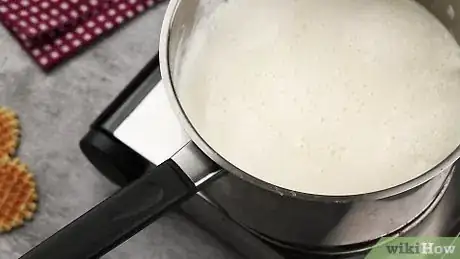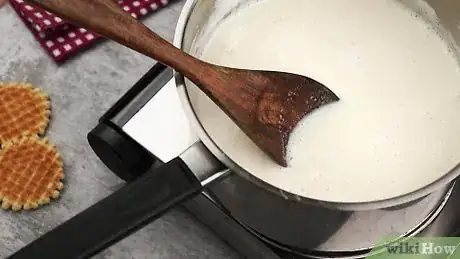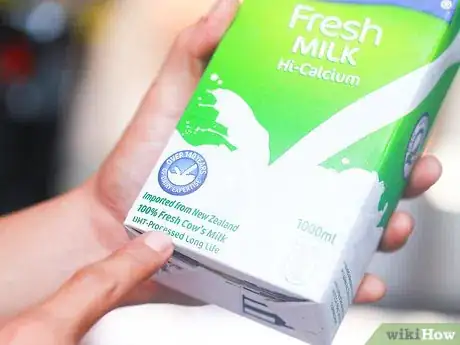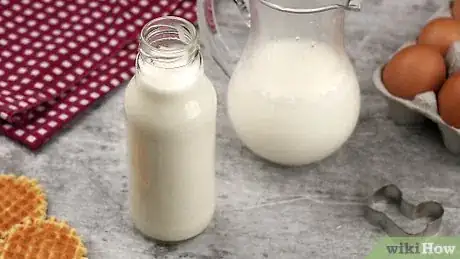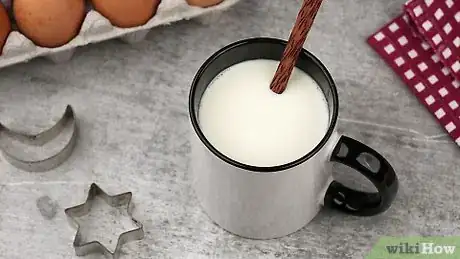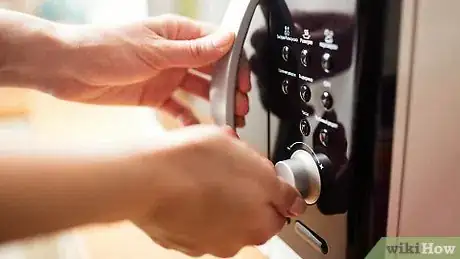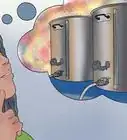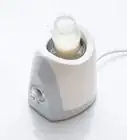wikiHow is a “wiki,” similar to Wikipedia, which means that many of our articles are co-written by multiple authors. To create this article, 14 people, some anonymous, worked to edit and improve it over time.
The wikiHow Culinary Team also followed the article's instructions and verified that they work.
This article has been viewed 318,537 times.
Learn more...
Boiling raw milk kills microbes and makes the milk safe to drink. Pasteurized milk is safe to drink cold, but boiling may extend its shelf life. If you just need to heat milk for cooking or to enjoy a warm cup, scalding it is faster and easier.
Steps
Scalding Milk
-
1Pour the milk into a clean pot. A thick-bottomed pot will heat the milk more evenly, reducing the chance of burning.
- Scalded milk, or milk heated to a temperature just below boiling, is good to use in recipes.
- If the milk is unpasteurized or if it's been stored at room temperature, boil it instead.
- Some people like to scald pasteurized milk as an extra precaution against microbes, but this is not necessary if it's been stored in a refrigerator.
- Impurities can spoil the milk, so clean the pot thoroughly.
-
2Heat over medium heat. Never heat over high heat, which is much more likely to burn the milk or cause overflow.Advertisement
-
3Stir occasionally. Keep an eye on the milk, stirring every minute or so. A wide spatula works best, since you can scrape the base of the pot if the milk starts to stick.[1]
-
4Watch for light bubbling and steaming. The milk is "scalded" once it has a tiny layer of foam at the top of the milk. Small bubbles will appear around the edge of the pot, and the surface will just barely steam.[2]
- If you have an infrared thermometer, confirm that the milk has reached 82ºC (180ºF).
-
5Continue heating for about fifteen seconds. Stir constantly to prevent overflow.
-
6Store the leftover milk. If you have milk left over after drinking or cooking, store it in an airtight container in the refrigerator. If this is not possible, store the container in a cool room. At warm temperatures, where bacteria thrive, milk will only stay good for four hours at most.[3]
Boiling Milk on the Stove
-
1Check whether the milk needs to be boiled. Some milk is safe to drink without boiling. Follow this guide when deciding whether to boil milk:
- Raw milk should be boiled whenever possible.
- Pasteurized milk should be boiled if it has been stored at room temperature. It does not need to be boiled if it's been in the refrigerator or a very cold room.
- A sealed tetra pack with "UHT" on the label is safe to drink, even if it's been stored at room temperature. UHT stand for "ultra high temperature," a type of processing which kills all harmful microbes.
-
2Pour the milk into a large, clean pot. Choose a taller pot than you need, so there's plenty of space. Milk foams up when it boils, and will often overflow from a small pot.
- Clean the pot thoroughly, or residue might curdle your milk. If this becomes a problem, choose a pot to use only for milk.
- Copper, aluminum, and stainless steel heat up much faster than cast iron and other heavy material. This saves time, but you'll need to pay extra close attention to prevent burning and overflow.
-
3Heat the milk until it starts to bubble. Heat the milk over medium heat and give it your full attention. A shiny layer of cream will rise to the top as it heats. Eventually, small bubbles will rise up from underneath the cream, starting around the outside edge. Once this happens, reduce heat to low.
- You may heat the milk over high heat to save time, but watch it constantly and be ready to reduce heat. Over high heat, the milk will rapidly move from the first bubbles to a rising layer of foam.
-
4Stir occasionally. If your pot heats unevenly, the milk may burn in places. Stir once every couple minutes with a wooden spoon or a heat-safe spatula, scraping the bottom of the pan.
-
5Break up the foam as it forms. The cream at the top of the milk traps steam as the milk boils. This steam will break up the cream into foam, which will rise rapidly and overflow out the pot. Respond quickly to prevent this:
- Reduce heat until the milk bubbles at a steady rate.
- Stir constantly to break up the foam.
- Leave the utensil in the pot (optional). This breaks up the cream surface, creating a gap for steam to escape through.[4] Just make sure the utensil can handle prolonged heat without burning.
-
6Boil for two or three minutes, stirring constantly. This is long enough to make your milk safe to drink. Further boiling will just destroy nutrients in the milk.[5]
-
7Store immediately. Pour the milk into a closed container right away. Store in the refrigerator, or in the coldest place in your home. If you keep the milk in the refrigerator, it does not need to be boiled a second time. If storing the milk at room temperature, you may need to boil it before each use.
- Boiling too many times will destroy nutrients. If you do not have a refrigerator, try to buy only as much milk as you can use in one sitting.
Boiling Milk in the Microwave
-
1Do not rely on this method to make raw milk safe. Microwaves can only boil the milk for a brief time before the milk overflows. This will still kill some microbes, but not enough to treat raw milk or milk stored at room temperature. Heat these over the stove instead.
-
2Pour milk into a clean mug. Avoid mugs with metallic paint, which are not microwave safe.
-
3Place a wooden utensil in the mug. Place a wooden spoon or chopstick in the mug. Use a utensil long enough that it can't fall under the milk. This lets steam escape up the handle instead of causing a foamy explosion.
-
4Microwave for 20 seconds at a time. Between each "zap," take out the milk and stir it for 5–10 seconds. This cautious method minimizes the risk of overflow.
Community Q&A
-
QuestionHow long will raw milk stay fresh after boiling it?
 Community AnswerUsually 24 - 48 hours. Anything more time than that is a risk for your intestines.
Community AnswerUsually 24 - 48 hours. Anything more time than that is a risk for your intestines. -
QuestionWhat causes the formation of bubbles when boiling milk?
 Community AnswerMilk is an emulsion of water, protein, fat, and other substances. The bubbles you see are water becoming vapor as the milk hits the temperature at which it changes from liquid to gas.
Community AnswerMilk is an emulsion of water, protein, fat, and other substances. The bubbles you see are water becoming vapor as the milk hits the temperature at which it changes from liquid to gas. -
QuestionWhat happens when I boil milk meant for general household milk (not raw milk)?
 Community AnswerYou have to keep a close eye on the temperature and the time you cook it, or it can scald (burn) in the saucepan.
Community AnswerYou have to keep a close eye on the temperature and the time you cook it, or it can scald (burn) in the saucepan.
Warnings
- Acidic foods can curdle the milk. This includes ginger and some other spices.⧼thumbs_response⧽
- Always make sure that the milk isn't rotten before cooking. Rotten milk smells really bad and should be poured out instead of being used. It can cause Food poisoning.⧼thumbs_response⧽
- Be sure to watch your milk while you are heating it up. Milk begins to boil a lot earlier than water does.⧼thumbs_response⧽
- Handle the hot pot with a cloth, oven mitt, or pair of kitchen tongs. Do not leave the pot unattended, especially if there are children or animals around.⧼thumbs_response⧽
References
- ↑ http://pastrychefonline.com/2014/05/30/how-to-scald-milk/
- ↑ http://pastrychefonline.com/2014/05/30/how-to-scald-milk/
- ↑ http://www.stilltasty.com/fooditems/index/17687
- ↑ http://www.pitara.com/science-for-kids/5ws-and-h/why-does-milk-spill-over-when-it-boils/
- ↑ http://timesofindia.indiatimes.com/city/pune/Do-you-boil-your-milk-the-right-way/articleshow/10561075.cms
About This Article
If you want to boil milk on the stove, put it over medium heat until bubbles start to form. As soon as you see bubbles, reduce the heat to low. Stir the milk once every couple minutes to let the steam escape and help the milk heat evenly. Once the milk has boiled for 2 to 3 minutes, store it in a closed container in the refrigerator. If you have to store the milk at room temperature, boil it again before each use.

